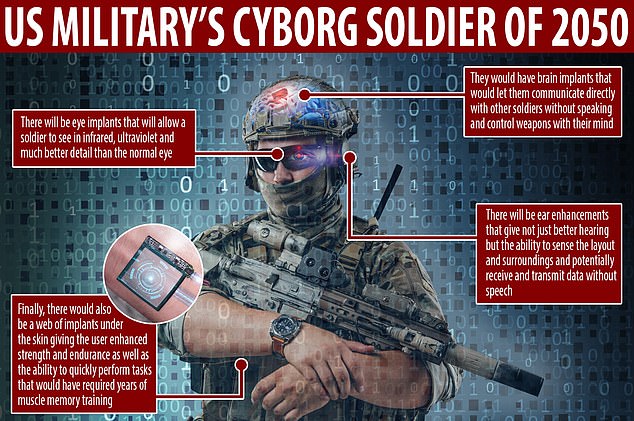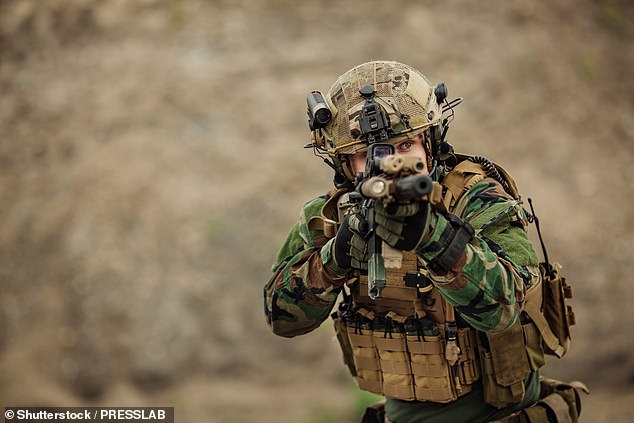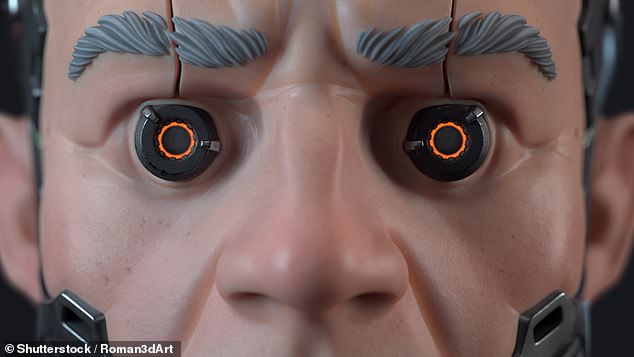space cadet
SENIOR MEMBER
Cyborg super soldiers: US Army report reveals vision for deadly ‘machine humans’ with infrared sight, boosted strength and mind-controlled weapons by 2050
PUBLISHED: 09:23 EST, 29 November 2019 | UPDATED: 10:45 EST, 29 November 2019
639shares
181
View comments
Future armies could be made up of half-human half-machine cyborgs with infrared sight, ultrasonic hearing and super strength, equipped with mind-controlled weapons.
In a US Army report, experts from Devcom - the Combat Capabilities Development Command - outlined a number of possible future technologies that could be used to enhance soldiers on the battlefield by 2050.
These include enhanced limbs for increased strength, an eye that provides infrared and ultraviolet vision, and an audio device that provides ultra- and subsonic hearing.

+12
They also suggest a future soldier could have a neural device that optimises brain power and allow them to control weapons with their mind.
The 'thought experiment' involved dozens of scientists, military personnel, ethicists and other experts discussing future technologies, what impact cyborgs would have on society and how it would change warfare.
The term 'cyborg' was first coined in a NASA study on the long-term impact of space study by Manfred Clynes and Nathan Cline.
The word is a portmanteau formed from cybernetic organism and is an organism that has been optimised by creating interactions between flesh and machine.

+12
The study involved breaking down the future design of a cyborg soldier into the main areas of enhancement likely to be possible by 2050.
They examined changes to the eyes, ears, brain and muscular system through four 'case studies' examining the different technologies that could be developed and what impact they would have on society and warfare.
The study predicted that human machine enhancements would become widely available before 2050 and likely be led by medical use rather than the military.
'The healthcare market will fuel human machine enhancements primarily to augment the loss of functionality from injury or disease', the report claims.

+12
SHARE THIS ARTICLE
Share
639 shares

+12
Devcon suggests that as well as being better fighters, enhancing soldiers with technology could improve their chance of survival if hit during battle.
'One could argue that failure to invest in responsible development of these potentially lifesaving technologies would be unethical.'
Authors of the report suggest that a lot of work would need to be done on changing 'hearts and minds' to make people more receptive of adapted soldiers, especially after they return to civilian life.
They say that an individual re-entering civilian life with enhanced abilities would have a defined competitive advantage over non-enhanced individuals.

+12
The team questioned whether soldiers with enhancements should be 'throttled' back to a normal level when entering society and if so what normal levels should be.
They also raised concerns over national security.
One participant in the study said: 'If I can’t walk into a sensitive compartmented information facility wearing an iWatch or carrying a cellphone, how will security be confident it is safe to allow a cyborg to walk in there?'
This was just a thought experiment and we are unlikely to see an 'enhanced soldier' with all of these changes by 2050, however there is some suggestion in the report that part, if not all of the technologies could be fairly common within 30 years.

+12
The Devcon team suggest the perception of cyborgs would need to be changed from one of danger to a more positive understanding.
'Across popular social and open-source media, literature, and film, the use of machines to enhance the physical condition of the human species has received a distorted and dystopian narrative in the name of entertainment.
'More accurate depiction of technology and its applications in fiction and nonfiction media could lay the groundwork for a new generation that sees opportunity for societal benefits in cyborg technologies;, the report says.
They say that if if technology is to become a more intimate partner in the physical enhancement of the human species then defence personnel would need to work to alter cultural narratives to create a 'more positive narrative'.
So what exactly does the study think will be developed in order to create the cyborg super soldier of the future?

+12
Enhanced vision through eye implants
This implant would likely overlay the existing ocular tissue and make use of retinal walls to show streams of data that would be sent through the optic nerve to the brain where they could be processed.
The study says that this data would be very different to what the optic nerve normally processes so fighters would have to learn how to understand and interpret what the brain is being fed.
They say this would offer small teams the ability to acquire and share data in real time including visual images in infrared and ultraviolet light.
The report suggests that this technology could also be used in medicine to give sight to people who are blind.

+12
Better muscle control through a sensor web
A web of sensors would be implanted under the skin of the soldier that would be networked to deliver stimulation through programmed light pulses.
The implanted network would be able to interact with external sensors in clothes, boots and eye wear linked to a central computer controller.
This network of sensor could make the muscles 'dance' in a consistent way and be used to improve performance, decrease injury and create automated hazard avoidance where the soldier's movement could be controlled remotely.
'The network could be programmed to control their bodies to perform complex tasks for which they are not accustomed. It would in effect, take control of the motions of a warfighter’s limbs, thereby allowing a novice to perform functions professionally.'

+12
Improved hearing through cochlea implants
Experts suggest that to improve hearing and communication abilities, especially in the early days of cyborg soldiers, the middle-ear bones and cochlea would need to be replaced or modified.
This would give those soldiers a greater dynamic range of hearing which would help filter overexposure and increase sensitivity to low-amplitude sounds.
This could expand to allow the fighter to hear infrasonic and ultrasonic sounds and allow for covert speech through neural signalling.
'The current level of evasiveness suggests that this technology would only be employed by individuals with significant hearing loss', the authors say.

+12
Technology control through brain implants
This would come in the form of direct neural enhancements that would allow data to be transferred between the human brain and technology as well as between two human minds without having to speak.
'These interactions would allow warfighters direct communication with unmanned and autonomous systems, as well as with other humans, to optimise command and control systems and operations', the report says.
The technology would likely involve electrodes being implanted into the brain giving the soldier the ability to directly communicate with others and machines.
'It is anticipated that specialized operators will be using neural implants for enhanced operation of assets by the year 2030', the report claims.
- Enhancements could be made to soldiers' eyes, ears, brain and muscular system
- As well as creating better fighters, this could improve their chances of survival
- The study predicts that these enhancements will be widely available by 2050
- The US Army Combat Capabilities Development Command created the study
PUBLISHED: 09:23 EST, 29 November 2019 | UPDATED: 10:45 EST, 29 November 2019
639shares
181
View comments
Future armies could be made up of half-human half-machine cyborgs with infrared sight, ultrasonic hearing and super strength, equipped with mind-controlled weapons.
In a US Army report, experts from Devcom - the Combat Capabilities Development Command - outlined a number of possible future technologies that could be used to enhance soldiers on the battlefield by 2050.
These include enhanced limbs for increased strength, an eye that provides infrared and ultraviolet vision, and an audio device that provides ultra- and subsonic hearing.

+12
They also suggest a future soldier could have a neural device that optimises brain power and allow them to control weapons with their mind.
The 'thought experiment' involved dozens of scientists, military personnel, ethicists and other experts discussing future technologies, what impact cyborgs would have on society and how it would change warfare.
The term 'cyborg' was first coined in a NASA study on the long-term impact of space study by Manfred Clynes and Nathan Cline.
The word is a portmanteau formed from cybernetic organism and is an organism that has been optimised by creating interactions between flesh and machine.

+12
The study involved breaking down the future design of a cyborg soldier into the main areas of enhancement likely to be possible by 2050.
They examined changes to the eyes, ears, brain and muscular system through four 'case studies' examining the different technologies that could be developed and what impact they would have on society and warfare.
The study predicted that human machine enhancements would become widely available before 2050 and likely be led by medical use rather than the military.
'The healthcare market will fuel human machine enhancements primarily to augment the loss of functionality from injury or disease', the report claims.

+12
SHARE THIS ARTICLE
Share
639 shares

+12
Devcon suggests that as well as being better fighters, enhancing soldiers with technology could improve their chance of survival if hit during battle.
'One could argue that failure to invest in responsible development of these potentially lifesaving technologies would be unethical.'
Authors of the report suggest that a lot of work would need to be done on changing 'hearts and minds' to make people more receptive of adapted soldiers, especially after they return to civilian life.
They say that an individual re-entering civilian life with enhanced abilities would have a defined competitive advantage over non-enhanced individuals.

+12
The team questioned whether soldiers with enhancements should be 'throttled' back to a normal level when entering society and if so what normal levels should be.
They also raised concerns over national security.
One participant in the study said: 'If I can’t walk into a sensitive compartmented information facility wearing an iWatch or carrying a cellphone, how will security be confident it is safe to allow a cyborg to walk in there?'
This was just a thought experiment and we are unlikely to see an 'enhanced soldier' with all of these changes by 2050, however there is some suggestion in the report that part, if not all of the technologies could be fairly common within 30 years.

+12
The Devcon team suggest the perception of cyborgs would need to be changed from one of danger to a more positive understanding.
'Across popular social and open-source media, literature, and film, the use of machines to enhance the physical condition of the human species has received a distorted and dystopian narrative in the name of entertainment.
'More accurate depiction of technology and its applications in fiction and nonfiction media could lay the groundwork for a new generation that sees opportunity for societal benefits in cyborg technologies;, the report says.
They say that if if technology is to become a more intimate partner in the physical enhancement of the human species then defence personnel would need to work to alter cultural narratives to create a 'more positive narrative'.
So what exactly does the study think will be developed in order to create the cyborg super soldier of the future?

+12
Enhanced vision through eye implants
This implant would likely overlay the existing ocular tissue and make use of retinal walls to show streams of data that would be sent through the optic nerve to the brain where they could be processed.
The study says that this data would be very different to what the optic nerve normally processes so fighters would have to learn how to understand and interpret what the brain is being fed.
They say this would offer small teams the ability to acquire and share data in real time including visual images in infrared and ultraviolet light.
The report suggests that this technology could also be used in medicine to give sight to people who are blind.

+12
Better muscle control through a sensor web
A web of sensors would be implanted under the skin of the soldier that would be networked to deliver stimulation through programmed light pulses.
The implanted network would be able to interact with external sensors in clothes, boots and eye wear linked to a central computer controller.
This network of sensor could make the muscles 'dance' in a consistent way and be used to improve performance, decrease injury and create automated hazard avoidance where the soldier's movement could be controlled remotely.
'The network could be programmed to control their bodies to perform complex tasks for which they are not accustomed. It would in effect, take control of the motions of a warfighter’s limbs, thereby allowing a novice to perform functions professionally.'

+12
Improved hearing through cochlea implants
Experts suggest that to improve hearing and communication abilities, especially in the early days of cyborg soldiers, the middle-ear bones and cochlea would need to be replaced or modified.
This would give those soldiers a greater dynamic range of hearing which would help filter overexposure and increase sensitivity to low-amplitude sounds.
This could expand to allow the fighter to hear infrasonic and ultrasonic sounds and allow for covert speech through neural signalling.
'The current level of evasiveness suggests that this technology would only be employed by individuals with significant hearing loss', the authors say.

+12
Technology control through brain implants
This would come in the form of direct neural enhancements that would allow data to be transferred between the human brain and technology as well as between two human minds without having to speak.
'These interactions would allow warfighters direct communication with unmanned and autonomous systems, as well as with other humans, to optimise command and control systems and operations', the report says.
The technology would likely involve electrodes being implanted into the brain giving the soldier the ability to directly communicate with others and machines.
'It is anticipated that specialized operators will be using neural implants for enhanced operation of assets by the year 2030', the report claims.
